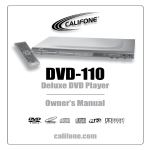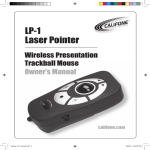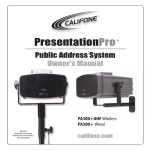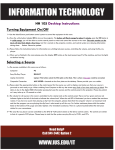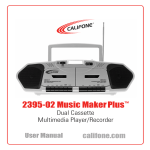Download PA-IRSYS Installed Infrared Audio System
Transcript
CAUTION RISK OF ELECTRIC SHOCK - DO NOT OPEN ! CAUTION: TO REDUCE THE RISK OF ELECTRIC SHOCK, DO NOT REMOVE COVER OR BACK. NO USER SERVICEABLE PARTS INSIDE. REFER SERVICING TO QAULIFIED PERSONNEL. The lightening flash with arrowhead within a triangle is intended to tell the user that parts inside the product are a risk of electric shock to persons. This product is not designed to function normally in strong electromagnetic fields. Consequently, the audio quality may degrade while the product is exposed to strong electromagnetic fields. Normal audio quality operation will be recovered when the strong electromagnetic field is no longer present. ! WARNING: TO REDUCE THE RISK OF FIRE OR ELECTRIC SHOCK, SO NOT EXPOSE THIS APPLIANCE TO RAIN OR MOISTURE. Infrared Classroom Audio System The exclamation point within a triangle is intended to tell the user that important operating and servicing instructions are in the papers with the appliance. Ce produit n’est pas conçu pour un fonctionnement dans de forts champs électromagnétiques. Par conséquent, la qualité sonore peut diminuer si ce produit est exposé à un fort champ életromagnétique. La qualité sonore redeviendra normale après affaib-lissement du champ électromagnétique. IMPORTANT SAFETY INSTRUCTIONS ATTENTION: ALL SAFETY AND OPERATING INSTRUCTIONS SHOULD BE READ BEFORE OPERATING APPLIANCE. ALL OPERATING AND USE INSTRUCTIONS SHOULD BE FOLLOWED WHEN OPERATING THE APPLIANCE. HEED AND ADHERE TO ALL WARNINGS ON THE APPLIANCE AND IN THE OPERATING INSTRUCTIONS. RETAIN ALL SAFETY AND OPERATING INSTRUCTIONS FOR FUTURE REFERENCE. WATER & MOISTURE - DO NOT USE THE APPLIANCE NEAR WATER; IE. BATHTUB, WASHBOWL, KITCHEN SINK, LAUNDRY TUB, WET BASEMENT OR SWIMMING POOL. VENTILATION - DO NOT SITUATE THE APPLIANCE SO THAT ITS LOCATION OR POSITION INTERFERES WITH ITS PROPER VENTILATION. FOR EXAMPLE, THE APPLIANCE SHOULD NOT BE SITUATED ON A BED, SOFA, RUG OR SIMILAR SURFACE THAT MAY BLOCK THE VENTILATION OPENINGS. THE APPLIANCE SHOULD NOT BE PLACED IN A BUILT-IN INSTALLATION, SUCH AS A BOOKCASE OR CABINET, THAT MAY IMPEDE THE FLOW OF AIR THROUGH THE VENTILATION OPENINGS. HEAT - SITUATE THE APPLIANCE AWAY FROM HEAT SOURCES SUCH AS RADIATORS, HEAT REGISTERS, STOVES OR OTHER APPLIANCES (INCLUDING AMPLIFIERS) THAT PRODUCE HEAT. POWER SOURCES - CONNECT THE APPLIANCE ONLY TO A POWER SUPPLY TYPE DESCRIBED IN THE OPERATING INSTR-UCTIONS OR MARKED ON THE APPLIANCE. GROUNDING OR POLARIZATION - PRECAUTIONS SHOULD BE TAKEN SO THAT THE GROUNDING OR POLARIZATION MEANS OF THE APPLIANCE ARE NOT DEFEATED. POWER CORD PROTECTION - POWER SUPPLY CORDS SHOULD BE ROUTED SO THAT THEY ARE NOT LIKELY TO BE WALKED ON OR PINCHED BY ITEMS PLACED UPON OR AGAINST THEM, PAYING PARTICULAR ATTENTION TO CORDS AT PLUGS, CONVENIENCE RECEPTACLES, AND THE POINT WHERE THEY EXIT FROM THE APPLIANCE. CLEANING - THE APPLIANCE SHOULD BE CLEANED ONLY AS RECOMMENDED BY THE MANUFACTURER. NON USE PERIODS - UNPLUG THE APPLIANCE POWER CORD FROM THE OUTLET WHEN LEFT UNUSED FOR A LONG PERIOD OF TIME. OBJECT & LIQUID ENTRY - CARE SHOULD BE TAKEN SO THAT OBJECTS DO NOT FALL AND LIQUIDS ARE NOT SPILLED INTO THE ENCLOSURE THROUGH OPENINGS. DAMAGE REQUIRING SERVICE - THE APPLIANCE SHOULD BE SERVICED BY QUALIFIED SERVICE PERSONNEL WHEN: (A) THE POWER SUPPLY CORD OR THE PLUG HAS BEEN DAMAGED (B) OBJECTS HAVE FALLEN OR LIQUID HAS BEEN SPILLED INTO THE APPLIANCE (C) THE APPLIANCE HAS BEEN EXPOSED TO RAIN (D) THE APPLIANCE DOES NOT APPEAR TO BE OPERATING NORMALLY OR EXHIBITS A MARKED CHANGE IN PERFORMANCE (E) THE APPLIANCE HAS BEEN DROPPED OR THE ENCLOSURE DAMAGED. SERVICING - THE USER SHOULD NOT ATTEMPT TO SERVICE THE APPLIANCE BEYOND THAT DESCRIBED IN THE OPERATING INSTRUCTIONS. ALL OTHER SERVICING REFER TO A QUALIFIED SERVICE PERSONNEL. Califone® International Inc. • 1145 Arroyo Avenue, # A • San Fernando, CA 91340 USA Toll Free 800.722.0500 | Toll Free Fax 877.402.2248 International Customers call 818.407.2400 or Fax 818.407.2405 califone.com PA-IRSYS Operating Instructions October 2008 califone_PA-IRSYS_manual_Rev2.indd 2-3 3/12/2010 12:39:56 PM PA-IRSYS Infrared Classroom Audio System Operating Instructions Control Panel Descriptions Front View, Front Facing Panel (5)(6) (9) (10)(13)(18) (12) Thank you for purchasing the Califone® PA-IRSYS Infrared Classroom Audio System. We encourage you to visit our website www.califone.com to register your product for its warranty coverage, to sign up to receive our newsletter, download our catalog, and learn more about the complete line of Califone® audio visual products, including portable and installed wireless PA systems, multimedia players and recorders, headphones and headsets, computer peripheral equipment, visual presentation products and language learning materials. Front View Forward Facing Panel A.(For Front Side View ( Open door ) Sound Adjustments) (19) (3) (4) (7) (8) (11) (15) (14) (2) (1) (16) (17) B.Front Top View View, Inside Facing Panel (For System Connections) Unpacking the Unit Inspect the unit once the packaging has been opened for any damage occurred during shipping & contact us immediately. Please keep the packing material for further use. (30) (21) Warranty Registration Califone warrants the Infrared Classroom Audio System to be free from defective material and workmanship for one year from the purchase date (six years for the speakers). Our “Project Intercept” Customer Satisfaction program will replace defective parts and repair malfunctioning equipment under this warranty when the defect occurs under normal use. (25) PA-IRSYS Contents All Damage Claims Must Be Made With The Freight Carrier Notify the freight carrier immediately if you observe any damage to the shipping carton or product. Repack the unit in the carton and await inspection by the carrier’s claim agent. Notify your dealer of the pending freight claim. • Control Panel • Two Control Panel keys • AC Power cord • User Manual • Two infrared ceiling sensors (PI30-SENSOR), each with an integrated 32’ connecting cable • HBM-316 microphone used with beltpack transmitter • Teacher Beltpack transmitter (PI30-BP) • Beltpack lanyard with neck strap • Student handheld microphone (PI30-HH) • Four 1.2V AA Rechargeable NiMH batteries (for use with handheld and beltpack microphones) • Two non-powered PI30-SP Returning Your Unit for Service or Repairs Should your unit require service, contact our Customer Service Department online at califone.com/techsupport or via email [email protected] or by phone at 800722-0500 / 818-407-2400 to first obtain an RA number before returning it back to Califone. The unit must be returned to our factory via prepaid transportation only after the factory issues an RA (Return Authorization) number which must be clearly written on the outside of the box. PA-IRSYSB • PA-IRSYS with two additional powered (PI30-PS) array speakers 1 califone_PA-IRSYS_manual_Rev2.indd 4-5 (20) (24) (28) (35) (31) (22 ) (26 ) (23) (27) (32) (35) (1) Power Switch (2) Main Power Fuse (3.15A) (30) (31) (3) IR Teacher Mic Volume Control (4) IR Student Mic Volume Control(22) (20) (23) (5) IR Signal Indicator (Teacher Mic) (21) (26) (6) IR Signal Indicator (Student Mic) (24) (27) (7) Mic 1 Volume Control (25) (32) (8) Mic 2 Volume Control (28) (9) Aux 1 Volume Control (29) (10) Aux 2 Volume Control (11) Treble Level Control (12) Bass Level Control (13) Master Volume Control (14) Beltpack Transmitter Recharging Station Beltpack Transmitter Recharge Status Indicator C. (15) Bottom View (16) Power Adapter (17) Handheld Microphone Recharging Station & Status Indicator (33) (18) Handheld Mic Holder (34) (19) Door Lock Front View Inside Panel (20) Mic 1 Input (Balanced XLR) (33) (21)Aux Mic 2Input Input (Unbalanced (22) 1 (3.5mm) 1/4”) (29) (1) Power Swich (34) (22) Aux Input 1 (3.5mm) (35) (2) Main Power Fuse (3.15A) (23) Output(Mono (Mono (23)Line Line Output 1/4”)1/4”) (24) Aux Input 2 (Stereo RCA) (3) IR Teacher Mic Volume Control (24) Aux Input 2 (Stereo RCA) (25) Mic Pre-out (Mono RCA) (4) IR Student Mic Volume Control (26) DC 18V In (25) Mic Pre-out (Mono RCA) Top View (5) IR Signal Indicator (Teacher Mic) (27) DC Out (26) 18VOutput In (+ terminal) (28) DC Speaker (6) IR Signal Indicator (Student Mic) (29) Speaker Output (- terminal) (27) DC OutCeiling Sensor Input (B) (7) Mic 1 Volume Control (30) Infrared (38) (28) Output (+ Input terminal) (31) Speaker Infrared Ceiling Sensor (A) (8) Mic 2 Volume Control (32) Speaker Cable Holder (29) Output (terminal) (9) Aux 1 Volume Control (33) Paging Input Volume Control (10) Aux 2 Volume Control (34)Infrared Paging Input Jack Sensor Input (B) (30) Ceiling (35) 25V / 70V Paging Input Sensitivity Switch (11) Treble Level Control (31) Infrared Ceiling Sensor Input (A) Bottom View (12) Bass Level Control TopCable and Bottom (32) Holder Views (13) Master Volume Control (33) Box Door (36) Panel Door (36) (38 ) (14) Beltpack Transmitter Recharging Station (37) (34) AC ACInput Input (37 ) (15) Beltpack Transmitter Recharge Status Indicator (38) Knockouts to feed wires through (35) Knockouts (16) Power Adapter (17) Handheld Transmitter Recharging Station & Status Indicator Visit us online at califone.com (18) Handheld Mic Holder (19) Door Lock (20) Mic 1 Input (Balanced XLR) (21) Mic 2 Input (Unbalanced 1/4”) 2 3/12/2010 12:40:02 PM (15) (16) (17) (18) (19) (20) Power LED Indicator Lock Ceiling Sensor Cable Plugs EXT Speaker Jack Front Cover AC Cord B.Rear Panel Specifications General FM Modulation 50Hz~15KHz 3dB Frequency Response 80dB SNR Control Panel 50W MAX PowerSpeakers Output than 1% of Distortion CAUTION: The included PI30-SP speakers have aless total impedance The Control Panel has two possible mounting configurations: Beltpack Transmitter and (17) (18)Mic (20)Description (19) Installation Beltpack Transmitter Transmits Voice to the Infrared Ceiling Sensors (1) (2) (3) (4) (5) (6) (7) (8) (9) Power LED Indicator Power Switch Battery Cover Infrared Transmitting Head MIC-IN Jack DC-IN Jack/Battery Charger Volume Control Belt Clip Battery Compartment 1. Option 1: The default configuration is the surfacethan 2pcs PI30-SP should be connected to the PA-IRSYS to avoid mount the box on the wall. The mounting ears are Transmitting Modedropping too low for the amplifier Infrared the impedance output. Speakers designed with 4 holes for screws. Wall anchors or other Transmitting Frequency ortotal 2.85Mhz with higher impedance ratings can be used as2.35MHz long as the hardware should be used as necessary to securely load impedance attach the box to the wall. Transmitting Range on the amplifier is not below 40 approximately feet 3 ohms. Option 2: The second configuration is a flush-mount. The Battery 2x1.2V rechargeable2.batteries 1. Consumption Install each of the PI30-SP non-powered speakers on mounting ears can be unscrewed, flipped around and Current 240mA the front & back walls of the room. Optimal placement is unscrewed into the holes towards the front of the box. approximately 3 feet below the ceiling in the middle of In this configuration, a hole will need to be made in Infrared Receiver the wall. the wall the same size as the control panel. The control Receiving Mode Infrared panel will protrude from the wall only enough to allow Note: If the PA-IRSYSB package has been purchased, then 4 for the door to open fully. Receiving Frequency 2.35MHz or 2.85MHz speakers (2 non-powered + 2 powered) can be connected to AF Output 650mV speakers AF 1KHz Tips: the PA-IRSYS Control Panel. The PI30-SP (non-powered) • Install the panel in an accessible area of the classroom Dimensions (W)120x(H)300mm should be connected as described above. The(L)270x PI30-PS speakers where computers and other external media sources should be connected as follows: can be easily connected to the panel. 1. Install the PI30-PS speakers on the wall in the desired locations. • Note that longer runs of cable and poorly shielded 2. Connect the line output (1/4”) of the control panel to one of cable can cause hum or other noise to enter the system the line inputs on one of the PI30-PS speakers (RCA jacks). and output through the speakers and other outputs. 3. Connecting the second PI30-PS speaker: • Plug the power of different equipment into the same 4. Option 1: The speakers can be daisy-chained by connecting power outlet when possible to avoid ground loops. Also one of the line outputs (variable or fixed) on one PI30-PS see “Connecting the System” on the right side of the speaker to the line input of the other PI30-PS speaker. inner door panel. 5. Option 2: A splitter may be put on the line output from about 5.3 ohms when connected in parallel. Therefore, no more Infrared Microphone (4) (5) (2) (1) (6) (8) (3) (7) (9) PI30-HH handheld student microphone Connects to receiver panel (16) 6. HBM-316 microphone shown with PI30-BP beltpack transmitter the control panel so that each PI30-PS speaker is fed with its own cable. Volume adjustment: Depending on if the speakers are daisy chained and if the fixed or variable line outputs, were used, the method to adjust the volume will be different. Adjust the volume levels of each of the speakers to achieve a balanced sound field in the listening area. Connecting the System Once the Control Panel is Installed Note: The connections described in the following section are found on the the inside facing panel of the control box. 1. Connect the two PI30-SP speakers to the Speaker Output Jacks (28, 29). 2. Connect the two individual or daisy-chained signal cables from the infrared ceiling sensors to the Infrared Ceiling Sensor Jacks (30, 31). 3. Connect the AC power cord to the Power Connector (34) on the bottom of the Control Panel and then to the wall outlet. 4. If an external amplifier or assistive listening system is used, connect the amplifier/assistive listening system input to the Line Output Jack (23). 5. When using an external sound source (such as a DVD/ VCR, computer or a Califone® media player), connect the output from the media source to one of the Aux In Jacks (22, 24). Depending on the cable you have and the output jack type of the external source, you may use either 3.5mm jack (Aux 1) or the RCA jacks (Aux 2). All Infrared Ceiling Sensors 1. Infrared Ceiling Sensors (two units are included) (1) Receiver Cover (2) Fixed Ear (3) Infrared External Input (4) Infrared External Output (5) Signal Cable with 32’ cord 2 1 2 4 3 1 5 Specifications Visit us online at califone.com General ) califone_PA-IRSYS_manual_Rev2.indd Modulation Frequency Response SNR 6-7 Power Output 3 FM 50Hz~15KHz 80dB 50W MAX 3dB Install the two included infrared ceiling sensors along an imaginary center line in the middle of the ceiling, with each sensor located approximately one third of the length of the room away from the back or front wall. Note: With proper installation, the Classroom Audio system (with two ceiling sensors) can be used in rooms up to 2,000 sq. feet in size. If greater coverage is needed, up to 4 ceiling sensors can be daisy-chained & connected to the control panel. Tip: If reception of the infrared microphones is noisy or the signal cuts out, try moving and/or rotating the receivers until better reception is obtained. Visit us online at califone.com 4 3/12/2010 12:40:05 PM Installation & Operation 6. 7. 8. stereo signals are automatically mixed down to a mono signal for playback through the system. The volume for the inputs can be controlled by the Aux Volume Controls (9,10). Turn all the Volume Controls to their minimum position (approximately 7 o’clock). The Treble and Bass (11, 12) controls should set to 12 o’clock (straight up). Turn on the Power Switch (2) and the power LED Indicator will light. The PA-IRSYS should now be operational. The Treble (11) and Bass (12) Control knobs can be adjusted to improve quality/intelligibility of the audio through the system. 4. Adjust the paging input volume to the desired setting. Note that the Master Volume must be also turned up for the signal from the paging system to be heard through the PA-IRSYS speakers. Due to this, the PA-IRSYS should not be relied on for emergency paging or announcements. Operating the Infrared Belt Pack and Handheld Microphones Notes: • The volume adjustments for the two wireless mics, the two auxiliary inputs, and the Master System controls described in the following section are found on the front facing panel. • The Beltpack Transmitter comes with a lanyard that can be slipped over the belt pack and hung around the neck. Connecting the System for Teleconferencing The Califone PA-IRSYS is specifically designed to work with PC/MAC teleconference systems such as Microsoft® Netmeeting. 1. When using a computer teleconference system plug the Mic Pre-out (25) to the line input on the computer. 2. Connect the PC line/headphone output to the Aux 1 (22) or Aux 2 Input (24) on the Control Panel. 3. By connecting the system in this configuration, all of the microphone signals from the PA-IRSYS (the wireless teacher & student mics, and connected wired mics 1 and 2) are mixed and sent into the PC and sent to the remote teleconference site. The microphone signals will still also come out of the PA-IRSYS speakers along with the audio from the remote teleconference site. 4. You can adjust the Master Volume (13) and Aux Input Volume (9, 10) to get an appropriate loudness and mix of the signals. Note: You may need to adjust volume settings of the microphones as appropriate to get a good level signal into the computer. You may also need to adjust sound settings in the application to use the appropriate inputs/outputs for the audio on your computer. Tip: Do not connect the Mic Pre-out to the microphone input of the computer as you may get a distorted sound. 1. 2. 3. 4. 5. 6. Connecting the System to a 25 / 70 / 100V Paging System Insert two 1.2V AA rechargeable batteries into the infrared Beltpack Battery Compartment (9), paying attention to the positive and negative poles. Then close the battery cover Turn on the Microphone Power Switch (1) and the power LED indicator will light, indicating that transmitter is ready to use. A couple seconds later the appropriate IR Signal LED (5, 6) will light red, meaning the receiver has good signal reception from that particular mic. If using the beltpack transmitter, adjust the Volume Control (7) on the side of the beltpack. Also, adjust the appropriate Wireless Mic Volume Control (7, 8) on the panel. The Master Volume will also need to be adjusted to an appropriate level At this point, the microphones should be heard through the system. Both of the wireless microphones can be used throughout a typical day on a single charge and should be recharged overnight while not in use (without taking out batteries). Both the Beltpack and Handheld Mics have Built-in Chargers (14, 17) and are to be placed into their respective charging stations and charged overnight. The LEDs on the Handheld and Beltpack Microphone chargers indicate when the system is charging the microphones and when charging is complete. The LEDs will light up red when charging and will turn green once the batteries are fully recharged. The output of a 25 / 70 / 100 V Paging System may be connected to the PA-IRSYS paging input for non-emergency paging. 1. To do this, first wire the paging system output to the included 2-pin phoenix connector. 2. Then plug the connector into the paging input jack. 3. Adjust the sensitivity switch to the appropriate setting. Visit us online at califone.com 5 califone_PA-IRSYS_manual_Rev2.indd 8-9 Operation & Specifications General Notes • • • System Specification Storage Temperature: Operational Temperature: Power Supply: The Master Volume controls the overall volume of the system. If the master volume is not up, then no sound will be output from the system speaker outputs. Because the PA-IRSYS wireless microphones use infrared signals, they are not suitable for outdoor use since direct sunlight can interfere with the transmission. Do not cover the infrared transmitter head on either the handheld microphone or the belt pack microphone as the transmission to the ceiling sensors requires line-ofsightfor clear noise-free operation. Amplifier Power: Frequency Response: THD: -25oC – 65oC 0oC – 45oC Integrated 100-240VAC 50/60Hz switching power supply 30W RMS (+/- 3dB): 20Hz – 20kHz <1% Infrared Microphones Belt Pack Microphone Carrier Frequency: Handheld Microphone Carrier Frequency: Microphone Recharging Time : (both handheld and beltpack) Microphone Operational Time: (both handheld and beltpack) Max Range: Troubleshooting There is no sound output. • Is the AC cord connected the Control Panel and to the power outlet? • Is the power switch on and the power LED lit? • If using the beltpack transmitter: • Is the power on the beltpack on and the power LED on the beltpack is lit? • If not, try new batteries. • Is the Teacher Mic Signal Indicator lit on the Control Panel? • If not, make sure the ceiling sensors are picking up the signal from the beltpack and that the IR transmission is not being blocked. • Is the volume control on the beltpack up? • Is the Teacher Mic volume control up? • Is the Master volume control up? • Are the speakers connected to the speaker outputs? 2.35MHz 2.85MHz Approx. 8 hours Approx. 5-6 hours continuous usage 40 feet (From microphone to ceiling receiver) If the above section has not fully answered your question, visit the FAQ section of our website califone.com/faqs or contact our Customer Service Department directly via email ([email protected]) or by phone at 800-722-0500 / 818-407-2400. There is feedback from the speakers. • Try decreasing the volume of the microphone, master volume control, etc. until there is no feedback. • Try adjusting the treble and base controls to reduce feedback. There is noise or hum from the speakers. • Check the installation: • Ensure that cables are as short as possible and not run next to noise-generating cables or equipment. • Ensure that power cables of different equipment use the same power outlet to avoid ground loops. Visit us online at califone.com 6 3/12/2010 12:40:06 PM Complimentary Products Complimentary Products The following Califone products compliment your Infrared Classroom Audio System Media Players to connect to the Classroom Audio System CD102 Personal CD Player that’s built school tough 8102 2396 The first MP3 player designed for school use with a built-in mic for podcasting and dual headphone jacks Multimedia player with variable speed playback and built in USB port to transfer files to and from a computer Visit us online at califone.com 7 califone_PA-IRSYS_manual_Rev2.indd 10-11 Visit us online at califone.com 8 3/12/2010 12:40:13 PM Array Speakers Caution Improper installation can cause serious injury. The hardware and this installation guide of the speakers and this system were designed for wall-mounted applications. For ceiling mounted uses, use only industry approved mounting methods and hardware. Califone will not be responsible for improper installation or subsequent damage. Depending on the chosen method/configuration of installation of the PA-IRSYS system, various national and local electrical and fire safety/building codes may be applicable. Please reference those codes before installing the PA-IRSYS to ensure compliance of the installation. Califone does not provide any warranty for improper installation of the PA-IRSYS or its components. Notes Clamping of any PI30 Series Field Array Speaker Wall Mounting of any PI30 Series Field Array Speaker ——————————————————————————————————————————— ——————————————————————————————————————————— ——————————————————————————————————————————— ——————————————————————————————————————————— ——————————————————————————————————————————— WARNING ——————————————————————————————————————————— Improper installation can cause serious injury. Use only industry approved mounting methods and hardware. Califone cannot be responsible for improper installation or subsequent damage. ——————————————————————————————————————————— ——————————————————————————————————————————— ——————————————————————————————————————————— ——————————————————————————————————————————— PI30-PS PI30-SP Powered Field Array Speaker Non-Powered Field Array Speaker ——————————————————————————————————————————— ——————————————————————————————————————————— ——————————————————————————————————————————— ——————————————————————————————————————————— ——————————————————————————————————————————— Visit us online at califone.com 9 califone_PA-IRSYS_manual_Rev2.indd 12-13 10 3/12/2010 12:40:16 PM






